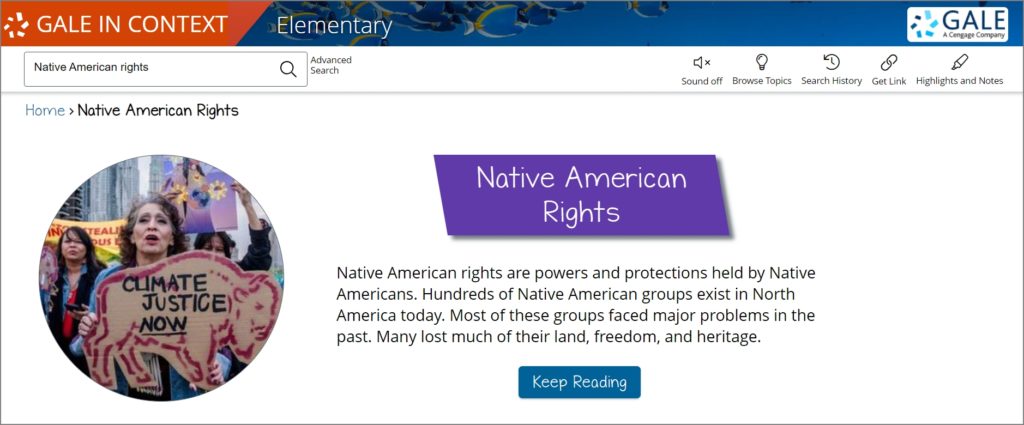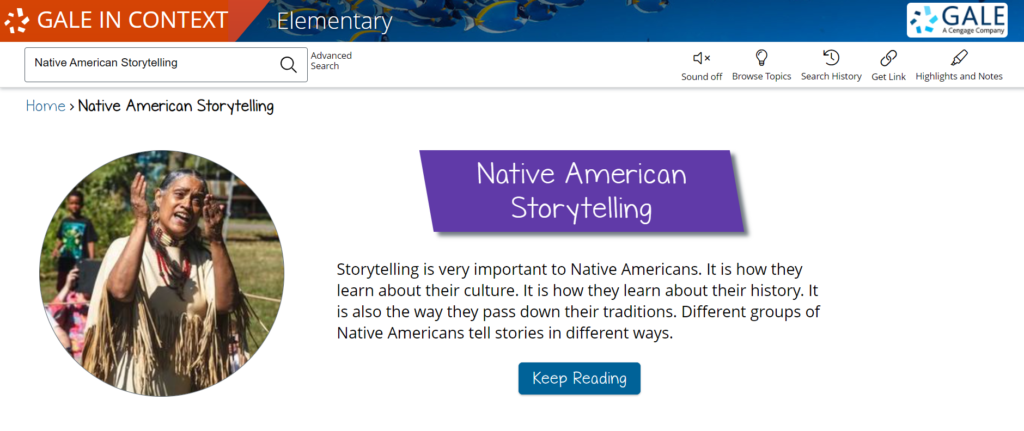| By Elizabeth Mohn |
Classroom teachers and school librarians strive to foster deep thinking and learning in the classroom. One way to do this is to focus on depth, not breadth, in learning. Native American history and culture are two areas where educators could encourage students to gain a deep understanding. Gale In Context: Elementary has several new resources to help educators foster understanding of Native American history and culture in their classrooms.
The new Native American Rights portal is a great place to start to help students gain a deep understanding of Native American history and culture. The portal can help students learn about the long struggle that Native Americans have taken part in to gain rights such as land protection and quality health care and educational opportunities. It also gives information about early Native American efforts to gain their rights and explains that the fight for Native Americans’ rights is ongoing. The portal has links to numerous resources that educators and students can explore together to gain an even deeper understanding. Educators can capture students’ interest with the biographies of Native Americans such as LaDonna Brave Bull Allard and Wilma Mankiller, who fought for Native American rights. The portal also has links to magazine articles that will help students learn about the fight for Native Americans’ rights. For example, the article “Native Americans and Alcatraz” discusses the Native American occupation of Alcatraz between 1969 and 1971. The article “Protest!” gives more information about the American Indian Movement, including its goals and achievements.

Fostering deep learning is more likely when students can connect to a topic. The new Native American Families portal can help students draw these connections to their everyday lives. The portal gives background information about Native American history and insight into the important traditions and values in many Native American families. It also provides related content that can help students think more deeply about Native American families. For example, the article “A Totem Pole Tradition” is about a family working to keep traditions alive. Educators can encourage students to think about important traditions in their families. The book Life on the Reservations is another resource that can help students learn about Native American families.
Educators can encourage students to direct their own learning by allowing them to choose to explore the new Native American Spiritual Practices portal or the new Native American Storytelling portal. Both resources will help students better understand Native American culture and give them the ability to guide their learning and will help engage and excite them. In the Native American Spiritual Practices portal, students can learn about rituals, celebrations, and spiritual beliefs that are common among Native American groups. Links in the portal allow students to learn more about individual Native American groups, as each group has its unique history and culture. The Native American Storytelling portal explains the importance of storytelling to most Native American cultures. Students can learn about oral traditions, myths and legends, and modern storytelling. The portal has several resources, including a magazine article explaining how Native Americans use art, such as dance and weavings, to tell stories. The linked “Oral Literature” article gives information about oral storytelling. It helps students make connections between Native Americans and other groups, such as enslaved people, who have rich oral-storytelling traditions.

Not a Gale In Context: Elementary subscriber? Learn more about this database >>

About the Author
Elizabeth Mohn is a writer and an educational content developer. When she’s not reading or writing, Elizabeth is usually spending time with her family, listening to podcasts, or working in her garden.

